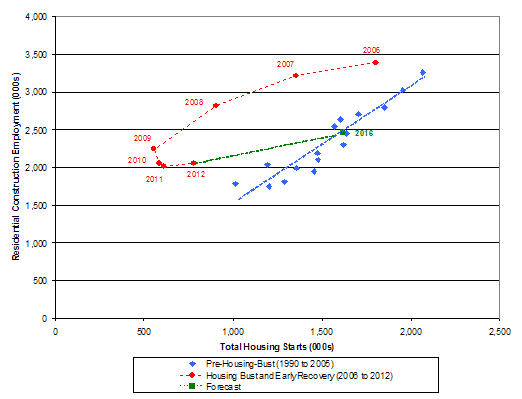When the Housing Market Returns to "Normal," How Much Will Residential Construction Employment Rebound?

The housing bust induced a 41 percent drop in residential construction jobs between 2006 and 2011.1 Fannie Mae's Economic and Strategic Research (ESR) Group predicts that homebuilding activity will return to "normal" by 2016, with housing starts roughly doubling over the next four years. (See Brian Hughes-Cromwick's and Orawin Velz's recent FM Commentaries.) The return to normal also implies an increase in residential construction employment, but how many jobs will be created by the homebuilding rebound? We explore this topic in our latest edition of Housing Insights.
ESR's housing construction forecast, which predicts that total starts will recover to 1.6 million units by 2016, suggests an increase of about 412,000 residential construction jobs between 2012 and 2016 (see the red 2012 data point and the green 2016 data point in the figure below).2 The expected 20 percent jump in homebuilding employment is roughly three times greater than the expected pace of total job growth during this period. However, we forecast that gains will not be rapid enough to bring back all homebuilding jobs lost during the housing bust. In 2016, the number of residential construction jobs is forecast to remain nearly 1 million fewer than at the peak of the housing boom.
A Return to a “Normal” Housing Market Won’t Restore All of the Lost Homebuilding Jobs

Sources: Census Bureau, Survey of Construction; Bureau of Labor Statistics, Quarterly
Census of Employment and Wages and Current Employment Statistics, ESR forecast
1 “Residential construction jobs” include employment in the construction of residential buildings and residential specialty trade contractors. For a detailed definition, see the accompanying Housing Insights.
2 Each data point in the chart shows residential construction employment (y-axis) and total housing starts (x-axis) for a single year. The figure depicts three periods: the “pre-housing-bust” period when total housing starts and residential construction jobs were highly correlated (blue data points); the “housing bust and early recovery,” during which the pre-bust linear correlation broke down (red data points); and ESR’s 2016 forecast (green data point). A key assumption of the ESR forecast is that the pre-bust linear relationship between starts and homebuilding employment re-emerges by 2016. For additional description of the forecast methodology used here and for forecast results based on a slightly different methodology, see the accompanying Housing Insights. The straight green line in the chart is used to connect the 2012 and 2016 data points in time sequence and is not intended to indicate an actual forecast path between these years.
The economic implications of a return to homebuilding normalcy extend beyond the forecasted growth in residential construction employment. A rebound in housing construction will produce positive ripple effects throughout the residential sector and across the broader economy by spurring home sales, mortgage lending, purchases of home furnishings, and manufacturing. However, the massive and lingering construction job losses created by the housing bust also present broader economic challenges, as many residential construction workers displaced by the housing downturn might never again find homebuilding jobs and might be forced to find employment in other sectors of the economy.
Patrick Simmons
Director, Strategic Planning
Economic and Strategic Research Group
May 6, 2013
The author thanks Orawin Velz, Doug Duncan, and Manhong Feng for valuable comments in the creation of this commentary. Of course, all errors and omissions remain the responsibility of the author.
Opinions, analyses, estimates, forecasts and other views of Fannie Mae's Economic and Strategic Research (ESR) group included in this commentary should not be construed as indicating Fannie Mae's business prospects or expected results, are based on a number of assumptions, and are subject to change without notice. How this information affects Fannie Mae will depend on many factors. Although the ESR group bases its opinions, analyses, estimates, forecasts and other views on information it considers reliable, it does not guarantee that the information provided in these materials is accurate, current or suitable for any particular purpose. Changes in the assumptions or the information underlying these views could produce materially different results. The analyses, opinions, estimates, forecasts and other views published by the ESR group represent the views of that group as of the date indicated and do not necessarily represent the views of Fannie Mae or its management.
The views expressed in these articles reflect the personal views of the authors, and do not necessarily reflect the views or policies of any other person, including Fannie Mae or its Conservator. Any figures or estimates included in an article are solely the responsibility of the author.
